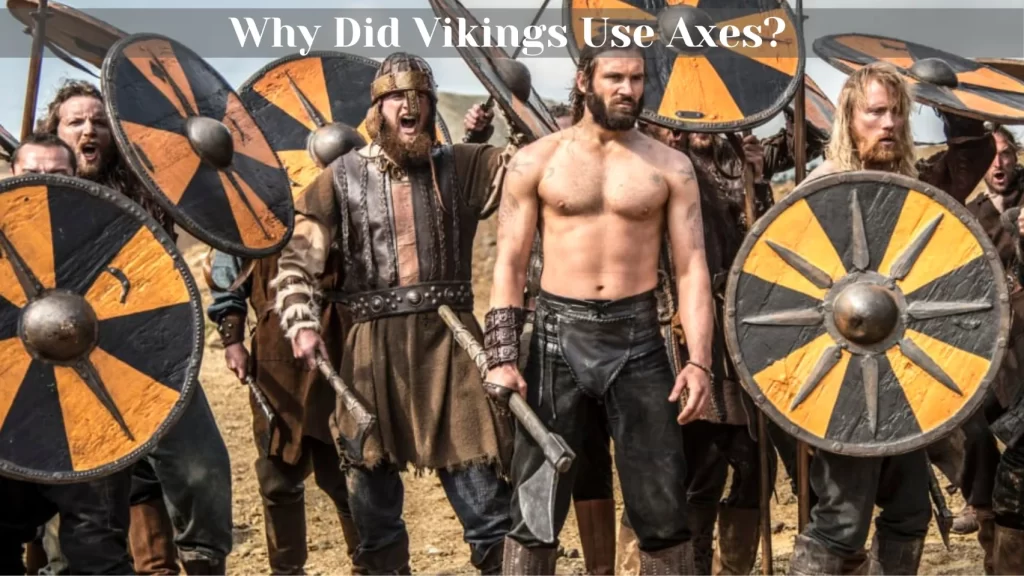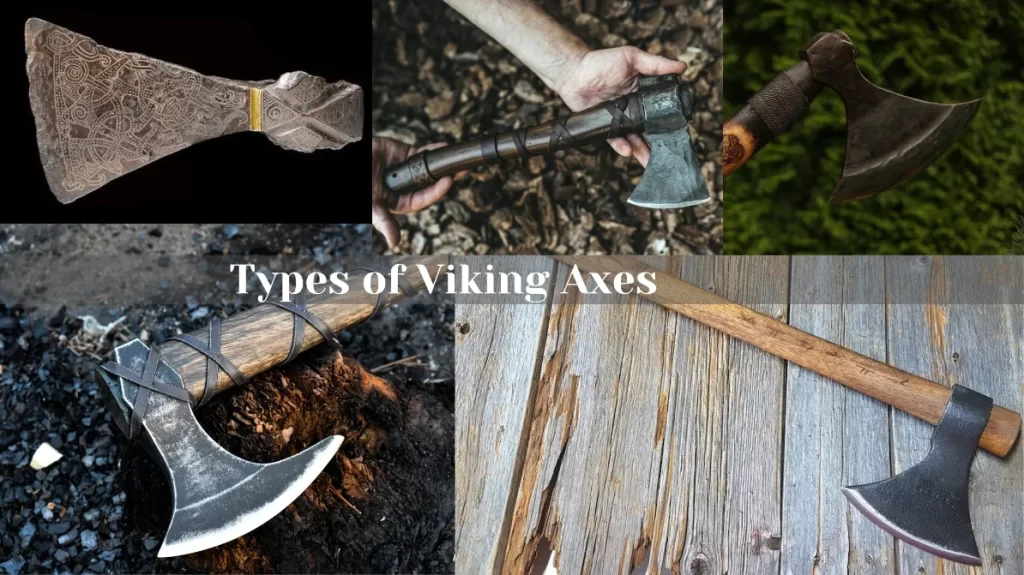The Vikings were fierce warriors known for their skill in battle, and their iconic axe was their weapon of choice. Imagine a Viking warrior clad in furs and steel, charges into battle, swinging a mighty axe. Indeed, an axe was a formidable weapon for Norse warriors. But why did Vikings used axes and preferred them over swords?

Contents
Why Did Vikings Use Axes?
The Viking used axes because they were practical, affordable and functional. An axe could be used as a war weapon, along with many other jobs, such as woodworking, building houses and ships, throwing, hunting, slashing, etc.
Let’s explore in detail the practical and symbolic reasons of axes in Norse society to find out why Vikings used axes instead of swords and how they carried their axes.
We have revealed the hidden truth behind what were Viking axes actually used for.
Practical Reasons Why Vikings Used Axes Instead of Swords
Everyday Tool of Vikings
One of the main reasons why Vikings used axes instead swords was their practicality. Axes were not only weapons, but also tools that Vikings used for various everyday tasks. Norse Vikings used axes for splitting logs for woodfire and fuel their longships, shaping timber for their longhouses, building houses and ships, and hunting and butchering animals, etc.
Cost Effective Production
Another reason was their cost effectiveness. Axes were cheaper and easier to produce than swords, which required more iron and skilled labor. Iron was scarce and expensive in Scandinavia, so the mighty double-edged swords were reserved for the wealthy and elite.
Axes, on the other hand, required less iron and could be made by any blacksmith. The reduced need for iron made them a more accessible weapon for a broader segment of the Viking population, while also ensuring that a broken or damaged axe could be more readily replaced.
Lethality
The Vikings used axes as weapons because of their lethal power and agility. Axes were deadly weapons that could easily cleave through armor and flesh. The sharp edge and heavy head of the axe could deliver a powerful blow that could split helmets, shields, and skulls with ease. Axes could also cause severe bleeding and shock, which could quickly incapacitate or kill an enemy.
Axes were also effective against shield walls, which were a common tactic in Viking warfare. The weight and force of the axe head could easily shatter even the strongest shields, creating gaps and openings for the attackers in battlefield.
Did Vikings women use axes in battle? Learn the truth!
Ease of Use and Easy Maintenance
Axes were simple and straightforward weapons that did not require much skill to wield. Unlike swords or other complex weapons, axes required minimal training to wield effectively. Their simplicity made them accessible to a wide range of fighters, not just the elite. Anyone could pick up an axe and swing it with force.
Axes were also easy to maintain compared to other weapons. They did not need to be sharpened often, as they could still cause damage even if blunt. Furthermore, they did not need to be oiled or cleaned, as they could withstand rust and corrosion.
Additionally, axes were less prone to breakage or damage in comparison to swords, allowing for greater longevity and durability in battle. The axe head was made of wrought iron, which was a strong and resilient material. Some of the low-cost axes were made using bog iron, which was common in Scandinavia. The axe handle was also made of sturdy wood, making it less likely to break.
A Common Tool
Do not forget the fact that most of the Vikings children grew up doing manual labor jobs, and they were handed over axes in young age. Probably an axe is one of the first tools they learn to use. As a result, when they grow old enough to raid, they are so comfortable swinging an axe fearlessly.
Read about the famous types of Viking axes and their uses.
Symbolic Reasons for Using Axes
Axes were not just practical and powerful weapons, but also cultural, status, and artistic symbols that represented the Viking identity, values, and beliefs.
Cultural Symbols
Axes were cultural symbols that personified the Viking spirit of adventure, exploration, and conquest. In Norse age, axes were associated with the god Thor and Odin. Odin was believed to be the god of thunder, lightning, and storms. He was also the patron of warriors, farmers, and travelers. Vikings admired Thor for his strength, courage, and generosity, and often invoked his name in battle or in oaths.
Odin, on the other hand, was the god of war and wisdom, and he was often depicted carrying a spear tipped with an axe blade.
In addition, axes were also linked to the concept of fate, or Wyrd, which governed the lives of Vikings. Axes were seen as instruments of fate, as they could determine the outcome of a fight or a life.
Status Symbols
Best of all, axes were status symbols that indicated wealth, power, and prestige among Viking warriors and chieftains. Some of the axes were expensive and rare compared to other weapons, such as spears or knives, and dangerous to use, requiring skill and courage.
Therefore, owning and wielding an axe was a sign of honor and respect among Vikings. Axes were also used as gifts or rewards for loyal followers or allies.
Artistic Symbols
A reason that can never be neglected, Vikings used to showcase their craftsmanship and decoration on their axes. Axes were often decorated with carvings, inlays, or runes to enhance their appearance and meaning. Some axes had elaborate patterns on their heads or handles, such as animals, plants, or geometric shapes.
Viking’s historical tapestries also depicts that some warriors had inscriptions or messages on their blades or shafts, such as prayers, curses, or boasts.
How Did Vikings Carry Their Axes?
Another aspect of Viking axes that is often overlooked is how they carried them. Unlike swords, which were usually carried in scabbards over the shoulder, or around the waist, axes did not have a standard way of being transported. Vikings had to improvise and use different methods and tools to carry their axes, depending on the situation.
Belt Sheaths
Vikings commonly relied on belt sheaths to carry their axes. These sheaths, crafted from sturdy leather, featured a slit or loop through which the axe handle could slide. This design allowed warriors to secure the axe to their belts, ensuring easy access during combats, hunting, or defending themselves.
Shoulder Straps
Vikings also utilized shoulder straps or slings to carry their axes. Typically fashioned from leather, these straps enabled the warriors to sling their axes across their backs. This carrying method was particularly useful during long journeys or extended periods of warfare. This method freed up their hands for other tasks, while keeping the weapon close by for swift deployment.
Axe Loops on Shields
To optimize their armament efficiency, Vikings attached axe loops to their shields, either by hooking it over the rim or by inserting it through a hole. This enabled the Viking to use both his shield and his axe in combat, switching between them as needed.
Alongside wielding their shields for protection, this ingenious placement allowed the warriors to carry their axes during battles. This multipurpose solution showcased the Vikings’ practicality and tactical thinking.
In a Wagon or Boat
Another way of carrying axes was to throw them into a wagon or a boat, along with other weapons and goods. This was convenient for long-distance travel or trade, but also made the axe less accessible and more vulnerable to theft or damage.
Final Words
We have thoroughly explored that why did Vikings use axes as their primary weapon. Vikings preferred axes over swords because they were cheaper and easier to produce than swords, making them more accessible to warriors of all social classes.
Also, axes were powerful and effective against armor, shields, and helmets. They were deadly weapons that could penetrate armor, crack shields, and dismember limbs.
We have also seen how axes were cultural, status, and artistic symbols that represented the Viking identity, values, and beliefs. Indeed, the Viking axes were a truly remarkable weapon, and it is no wonder that it was the Vikings’ primary weapon of choice.
Frequently Asked Questions
What are the advantages of the Viking axe?
The Viking axe had several advantages over other weapons, such as swords or spears. The Viking axe was cheaper and easier to produce and acquire than swords, which required more iron and labor. The Viking axe was also more effective against armor and shields, as it could penetrate or shatter them with its sharp edge and heavy head. The Viking axe was also more versatile than spears, as it could be used for both slashing and thrusting, or thrown as projectiles.
Were axes better than swords?
Whether axes or swords were better weapons depends on the situation. Axes were more practical and powerful, but swords were more versatile and easier to carry. In battle, axes were the better choice because they were more effective against armor and shields. However, swords were better for fighting unarmored opponents or in close quarters. Ultimately, the best weapon is the one that you are most skilled in using.
Did all Vikings use axes as their primary weapons?
No, not all Vikings exclusively used axes as their primary weapons. While the Viking axe was a popular and iconic choice, the preference for weaponry varied among different Viking individuals and communities. Some warriors favored swords, spears, or other types of weapons depending on their combat styles and regional influences. The axe, however, held a special place in Viking culture and history.
How did Vikings sharpen their axes?
Vikings sharpened their axes using whetstones, stones with a fine-grained surface that could grind and hone the edge of the blade. Whetstones were common and portable items that Vikings carried with them on their travels and raids.
Whetstones were often made of sandstone, slate, or quartz, and sometimes had grooves or holes to hold water or oil. Vikings would rub the blade of the axe against the whetstone at an angle, applying pressure and moving it back and forth until it was sharp enough.



